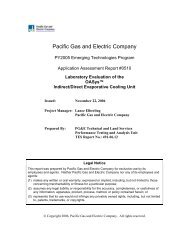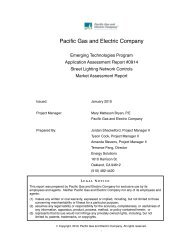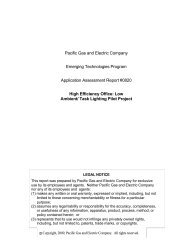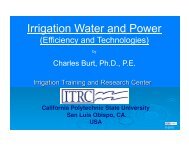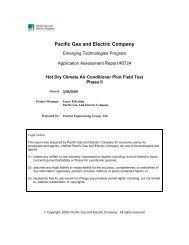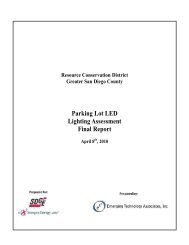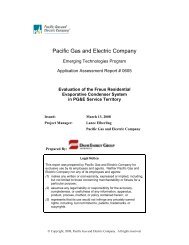PGE Water Heater ET Final Report - FINAL.pdf - Emerging ...
PGE Water Heater ET Final Report - FINAL.pdf - Emerging ...
PGE Water Heater ET Final Report - FINAL.pdf - Emerging ...
Create successful ePaper yourself
Turn your PDF publications into a flip-book with our unique Google optimized e-Paper software.
PG&E’s <strong>Emerging</strong> Technologies Program <strong>ET</strong>12<strong>PGE</strong>3191<br />
ENERGY STAR specifications, are tremendous; 20 million therms and 60 million kWh per<br />
year in PG&E’s service territory.<br />
While almost 30 percent of all models have ENERGY STAR certification, market penetration<br />
for these highly efficient models is less than 6 percent nationally. One of the biggest factors<br />
in the low penetration rate is price differential between standard models and energy saving<br />
models. Difficult economic conditions have also caused consumers to defer water heater<br />
replacement or to select lower priced, less efficient options.<br />
More than two dozen utilities across the U.S. have instituted water heater rebate programs<br />
to help overcome the price barrier and deliver energy savings. While many programs have<br />
the low participation rates that PG&E has experienced, there are a few benchmark programs<br />
that show promise to grow the market for energy efficient water heating products.<br />
There are additional barriers to achieving significant market penetration of efficient water<br />
heaters in California because of ultra-low NOx air emissions requirements. Even though<br />
there are nearly 250 gas-fired storage water heater models that satisfy these rules and in<br />
excess of 200 models that have the ENERGY STAR label, only a dozen natural gas models<br />
satisfy both sets of criteria. Transformation of the PG&E market is contingent on stocking<br />
qualified models, creating opportunities for incremental sales and profits for retailers and<br />
contractors, and timely promotion of the benefits of these models to consumers.<br />
A retailer-centered program strategy offers excellent prospects for engaging customers,<br />
influencing manufacturers, and gaining insights into the contractor channel. Market<br />
concentration in the water heater industry provides retailers access to large segments of<br />
consumers and direct connections to manufacturing. Three leading water heater retailers,<br />
Home Depot, Lowe’s, and Sears, have significant market share and are supplied by two<br />
manufacturers, A.O. Smith and Rheem, that produce more that 80 percent of residential<br />
water heaters.<br />
Benefit to cost analyses indicate that a water heater program portfolio, spearheaded by<br />
ENERGY STAR natural gas and electric heat pump storage water heaters, has the potential<br />
to meet market challenges. The high energy savings benefits of these technologies more<br />
than offset major program costs of rebates and marketing. Rebates as a percentage of<br />
product prices have to be higher than those in previous water heater programs. Marketing<br />
efforts need to be closely coordinated with channel partners and account for typical<br />
emergency driven decisions. Preliminary conversations with potential retailer partners have<br />
provided insights into the level of incentives and types of promotions necessary to influence<br />
selection of products to display, promote, and sell in their stores.<br />
PROJECT RECOMMENDATIONS<br />
The recommended course of action is to execute a test program in 2013 that would prove<br />
techniques for overcoming market barriers. Tests would be focused efforts in targeted,<br />
retail markets that have a high propensity towards participation in rebate programs. Two<br />
measures are in the test program: electric heat pump water heaters and ENERGY STAR<br />
natural gas storage water heaters. The three leading retailers will be approached to be the<br />
channel partners and collaborators in program design. The marketing approach will<br />
accentuate creating urgency and value for the consumer while addressing two separate but<br />
related objectives; delivering information in an emergency purchase and driving purchasing<br />
behavior towards a planned purchase. Critical success factors for the test are to engage top<br />
three retail partners, increase the number of qualified products stocked in the stores, and<br />
produce measurable energy savings.<br />
2



